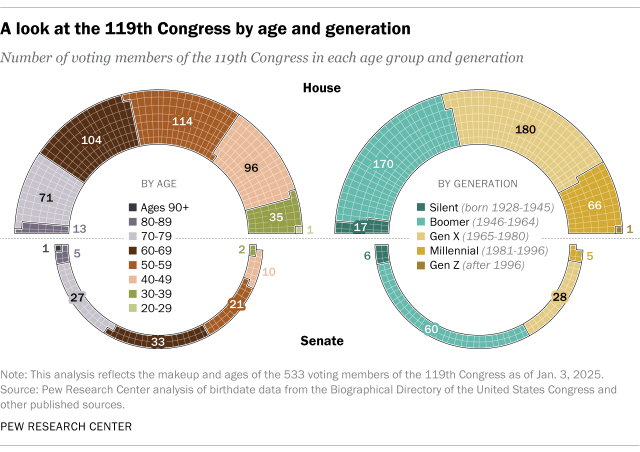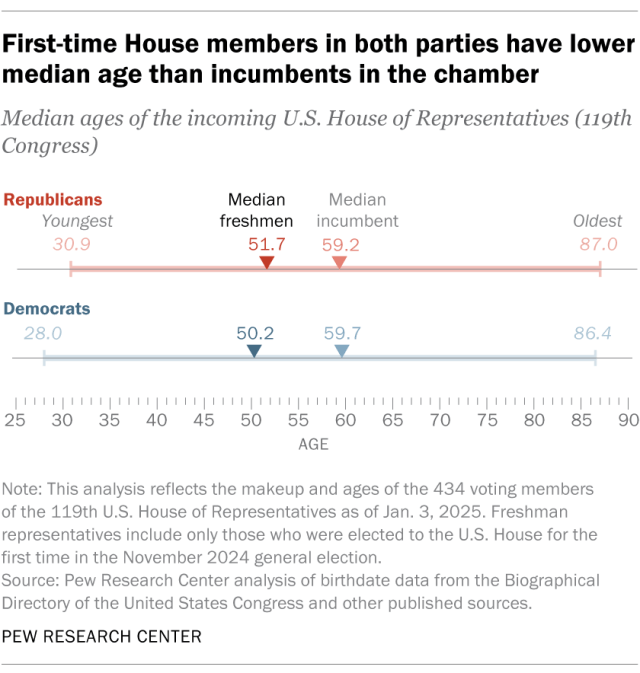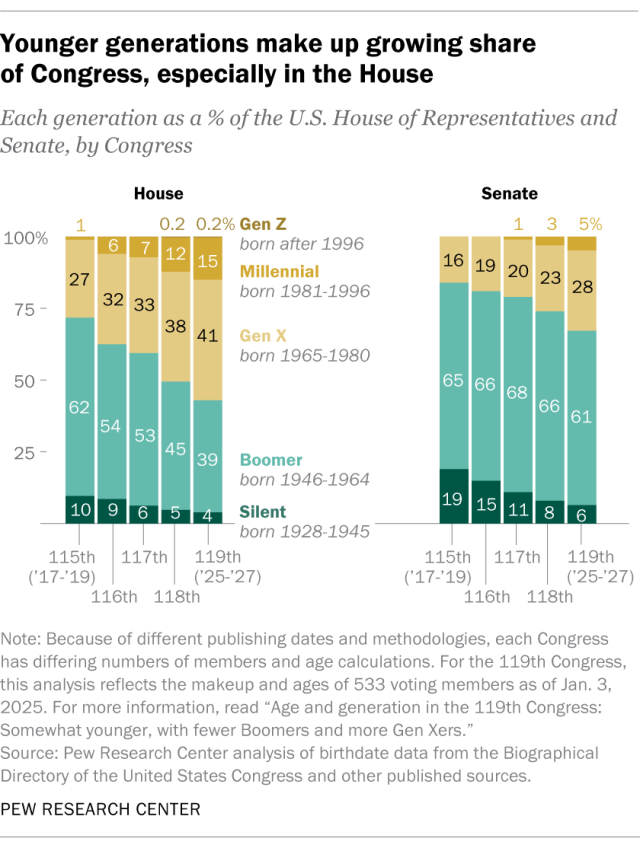The U.S. Congress is getting younger – on the whole, at least – according to a Pew Research Center analysis of representatives and senators in the new 119th Congress.
The median age of voting members of the House of Representatives is now 57.5 years. That’s down from 57.9 at the start of the 118th Congress (2023-25), 58.9 in the 117th Congress (2021-23), 58.0 in the 116th (2019-21) and 58.4 in the 115th (2017-19).
The Senate, following the death or retirement of some of its oldest members, has reversed its aging trend. The new Senate’s median age is 64.7 years, down from 65.3 at the start of the previous Congress. The median age of the Senate had previously risen for three Congresses in a row: from 62.4 (115th) to 63.6 (116th), to 64.8 (117th) and to 65.3 (118th).

This analysis of the newly seated House and Senate includes members who were sworn in on Jan. 3, 2025, the first day of the new Congress. It does not include West Virginia Sen. Jim Justice, who was sworn in on Jan. 14.
Pew Research Center conducted this analysis to determine the age and generational makeup of the 119th Congress, including how it differs from that of prior Congresses.
For this analysis, we obtained ages and birthdates of all senators and representatives in the 119th Congress as of Jan. 3, 2025, the first day of the new Congress. Our main source was the online Biographical Directory of the United States Congress, supplemented by other sources such as The Hill’s new members guide, directories of state officials and campaign websites. For newly elected members, we also reached out directly to their campaigns for confirmation. Historical data for the 115th, 116th, 117th and 118th Congresses came from prior Center analyses.
For the 119th Congress, our analysis reflects the ages of 533 voting members as of Jan. 3, 2025. The count does not include West Virginia Sen. Jim Justice, who was sworn in on Jan. 14. Florida’s 1st District seat, vacant after Republican Matt Gaetz said he would decline to take the seat he won in November 2024, won’t be filled until an April 1 special election and is excluded from all calculations.
The term “freshmen” refers only to lawmakers elected to their chamber for the first time this past November. Independent members of Congress are counted with the party they caucus with.
For the 118th Congress, the analysis reflects the ages of 534 voting members as of Jan. 3, 2023 (except for Sen. Pete Ricketts, R-Neb., who was included despite not being seated until Jan. 23, 2023). For the 117th Congress, the analysis reflects the 532 voting members seated as of Feb. 8, 2021, and ages were as of that date. For the 116th Congress, the generational makeup of the House was calculated as shares of the 432 seats called as of Nov. 21, 2018; ages were effective Jan. 3, 2019. Senate figures were based on all 100 members seated as of Jan. 3, 2019. For the 115th Congress, the analysis reflects the makeup and ages of all 535 voting members as of Jan. 3, 2017.
Newly elected members skew younger

Sixty-one new House members were elected for the first time in 2024; three others are former congressmen coming back for a second stint.
A large majority of the 119th House’s first-time members (48 of 61) are below the chamber’s median age of 57.5. The median age of new representatives is 50.2, compared with 46.3 among new members in the previous Congress.
About half (30) of the first-time members are in their 30s and 40s; the youngest, Rep. Brandon Gill, R-Texas, will turn 31 in February. At the other end of the age spectrum, two freshman representatives (George Latimer of New York and Sylvester Turner of Texas, both Democrats) are in their early 70s.
In the Senate, the 11 new members seated as of Jan. 3 have a median age of 53.9, well below that of the Senate as a whole. Four of the new senators (three Democrats and one Republican) are in their 40s, while one – Tim Sheehy, R-Mont. – is in his 30s. Justice, who is 73, became the oldest “freshman” after he was sworn in on Jan. 14.
Differences by party
In the House, the 30 newly elected first-time Republican representatives skew a bit older than their 31 Democratic counterparts: The median age of freshmen House Republicans is 51.7, compared with 50.2 for first-time Democrats in that chamber.
Overall, the median age of House Democrats is 57.6, while the median age of House Republicans is 57.5.
In the Senate, the median age of all Democrats is 66.0, a bit higher than the median for Republicans (64.5).
New Congress has more Millennials and Gen Xers – and fewer Boomers

Another way to look at the age of the new Congress is through the lens of generation. And this year marks a notable generational transition: Baby Boomers are no longer the largest generation in the House. As recently as two Congresses ago, Boomers (those born between 1946 and 1964) were a majority of both senators and representatives.
On the first day of the 119th Congress, Boomers still comprised a solid majority of the Senate (60 out of 99 senators) but accounted for just 170 House members, or 39%.
Gen X takes the House
In the House, the largest generation is now Generation X (born between 1965 and 1980), with 180 members, or 41%. Sixty-six representatives, or 15%, are Millennials (1981-96); and 17, or 4%, belong to the Silent Generation (1928-45). One representative, Florida Democrat Maxwell Frost, belongs to Generation Z (those born after 1996).
Some other generational trends:
- Among the House’s 61 freshman lawmakers, 35 are Gen Xers, 19 are Millennials and seven are Boomers.
- Republicans outnumber Democrats among Xers (94 to 86) and Boomers (89 to 81). Democrats predominate among the Silents (13 to 4), while Millennials are nearly evenly split (34 Democrats, 32 Republicans).
Boomers keep the Senate
Over in the Senate, there are only 28 Gen Xers, along with six Silents and five Millennials. Since the minimum age to be a senator is 30, no Gen Zers are yet eligible to serve there.
In addition, as of Jan. 3:
- About half of the 11 newly elected senators (six) are Xers, while three are Boomers and two are Millennials.
- As in the House, Republicans outnumber Democrats among Boomers (31 to 29) and Xers (15 to 13). Three Millennial senators are Republicans and two are Democrats; the six Silent Generation senators are split evenly between the parties.
The changing generational profile of Congress is linked to other shifts on Capitol Hill. For example, the slow decline in lawmakers who are members of the Baby Boom or Silent generations – many of whom came of age during the U.S. military engagements in Korea and Vietnam – has accompanied a long-term decrease in the share of legislators who are veterans. And the arrival of younger generations of lawmakers has brought additional changes, including growing racial and ethnic diversity in Congress.
